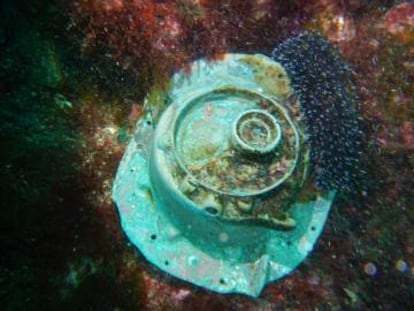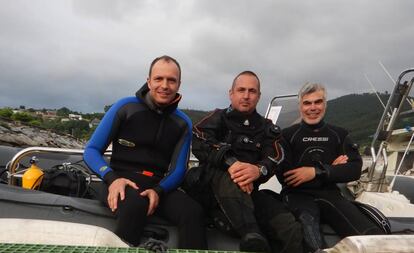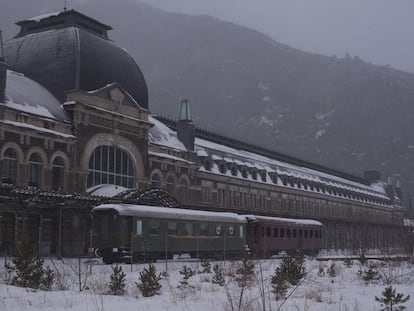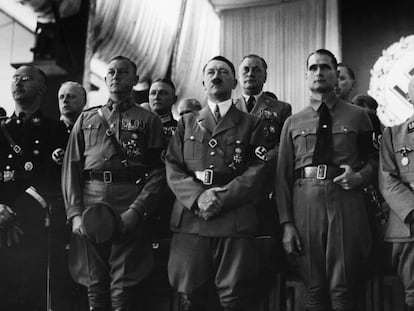How three Spaniards discovered a Nazi submarine in Galicia
A German sub has been uncovered after years of research, unsuccessful dives and a local tip off
Finding a wreck at the bottom of the sea is no easy feat. For Spanish researchers Anxi Gonz¨¢lez Roca, Eduardo Losada and Yago Abilleira it was a process that took almost a decade.
After years of research and failed diving expeditions, the trio finally found the remains of the U-966 Nazi submarine Gut Holz. The discovery, made off the coast of Galicia in Spain¡¯s north, was prompted by a clue from a local fisherman who had ¡°a large aluminum sheet covering the chicken coop at his house,¡± explains Roca, vice president of the Viverio Center of Subaquatic Activities in Lugo. ¡°It is part of the airframe of a WWII fighter plane, we think one belonging to the Allied forces¡± that fought the Nazi submarine in the Spanish cove Estaca de Bares on November 10, 1943.

The submarine, which could hold up to 50 crew members, had set off from the Blohm & Voss shipyard in Hamburg just eight months before the fateful battle. Dozens of fighter planes from Britain and the United States fought in the battle, which lasted almost two days. The Nazi submarine sunk fewer than 500 meters form Maeda Point after a second assault from the enemy. A Short Sunderland from the British Royal Air Force was also shot down by artillery. It broke in two and the tail end floated toward the mouth of the Ortigueira river.
The research team was led to what was left of the German sub after it was battered by aerial fire and then blown up by the Nazis ¨C a tactic used to keep their technology secret from their enemies. Anything left was stripped by a scrap company some years later. But thanks to the Galician fisherman who found the metal airframe, the divers now also know where the remains of the British Short Sunderland are located.
¡°We have the point,¡± says Anxo Gonz¨¢lez. If the location is confirmed, the group of friends will have closed the final chapter of a World War II story that has captured historians like Juan Carlos Salgado and Jos¨¦ Antonio Tojo.

Fourteen young German and British soldiers died on November 10 when the Nazi submarine and British aircraft were destroyed. Their bodies were buried two days later at a graveyard in Mogor in Ma?¨®n and then moved respectively to a German war cemetery in C¨¢ceres and British cemetery in Loiu in the Basque country.
The Civil Guard mobilized local fishermen to help rescue the survivors and save the three wounded from the rough conditions. Many local Spanish fisherman still have the honorary awards given to them by the Nazi forces for their help in the rescue effort ¨C although most would be reluctant to show them.
Most of the Nazi soldiers were taken to the Venecia en Viviero hotel in Lugo. Ekkehard Wolf, the German commander who was then aged 25 and known to his crew as ¡°the old man,¡± ended the onslaught by hoisting the flag of the burning submarine. He was later falsely proclaimed to be dead and returned home from Madrid on a commercial flight using a fake identity.

But Wolf returned many times to Spain, spending vacations in the country with his wife and children. One of his sons even ended up marrying a local woman from Barquiero in A Coru?a. Wolf¡¯s last wish, when he died in 1978, was for his ashes to be scattered between Cabo Ortegal and Estaca de Bares where his men had died.
While everything of worth in the Gut Holz submarine (meaning ¡°Good Wood¡±) was scrapped, many vestiges of the Nazi vessel were scattered between 14 and 26 meters under the sea.
The exact location of the sub was forgotten over time ¨C everyone presumed to know where it was but nobody could find it.
On their umpteenth dive, the trio found the wreck after spending two hours underwater. They spotted the shell of the U-966 submarine, which after decades had been taken over by seaweed, mollusks and fish. The divers took photos and recorded what they saw: a huge metallic mesh used for grip on the gangway, taps and valves, sheathed cable.
The group told the Spanish Navy about the find after the dive. Even if no one collects the wreck, ¡°we always tell people what we find on our expeditions,¡± explains Anxo Gonz¨¢lez. According to the diver, ¡°the best naval museum is under the sea.¡±
In addition to the Nazi sub, Gonz¨¢lez says they have also ¡°found porcelain, old cannon, a Roman anchor and last year the wreckage of the Tromp¡± a Dutch vessel of 100 meters in length that was attacked in 1917 by a German submarine off the coast of Lugo. They now have their eyes set on the British Short Sunderland.
English version by John Clarke
Tu suscripci¨®n se est¨¢ usando en otro dispositivo
?Quieres a?adir otro usuario a tu suscripci¨®n?
Si contin¨²as leyendo en este dispositivo, no se podr¨¢ leer en el otro.
FlechaTu suscripci¨®n se est¨¢ usando en otro dispositivo y solo puedes acceder a EL PA?S desde un dispositivo a la vez.
Si quieres compartir tu cuenta, cambia tu suscripci¨®n a la modalidad Premium, as¨ª podr¨¢s a?adir otro usuario. Cada uno acceder¨¢ con su propia cuenta de email, lo que os permitir¨¢ personalizar vuestra experiencia en EL PA?S.
?Tienes una suscripci¨®n de empresa? Accede aqu¨ª para contratar m¨¢s cuentas.
En el caso de no saber qui¨¦n est¨¢ usando tu cuenta, te recomendamos cambiar tu contrase?a aqu¨ª.
Si decides continuar compartiendo tu cuenta, este mensaje se mostrar¨¢ en tu dispositivo y en el de la otra persona que est¨¢ usando tu cuenta de forma indefinida, afectando a tu experiencia de lectura. Puedes consultar aqu¨ª los t¨¦rminos y condiciones de la suscripci¨®n digital.











































